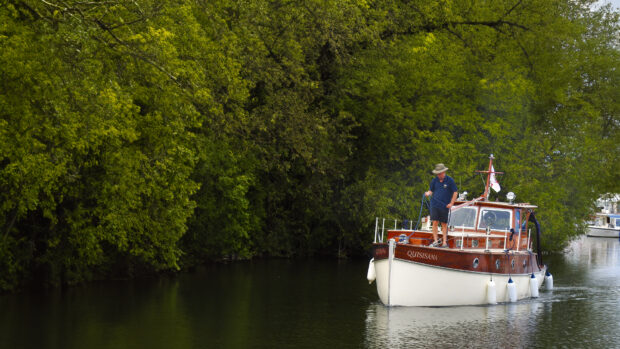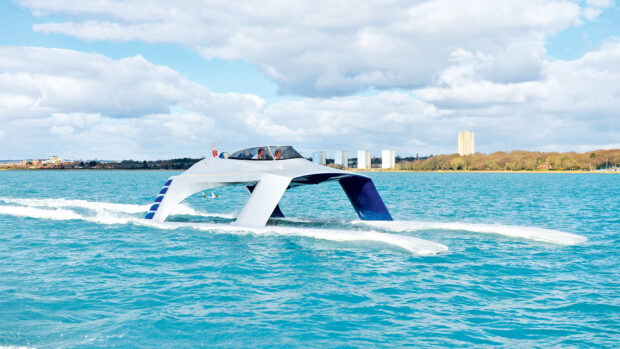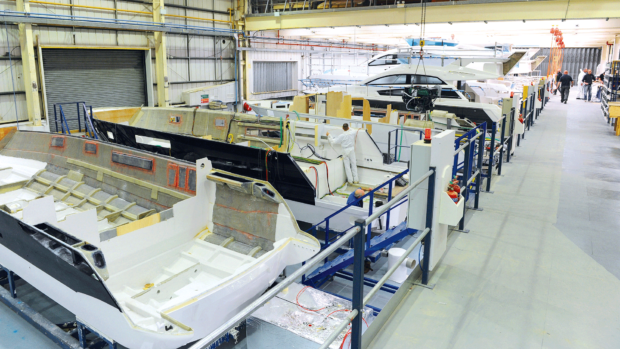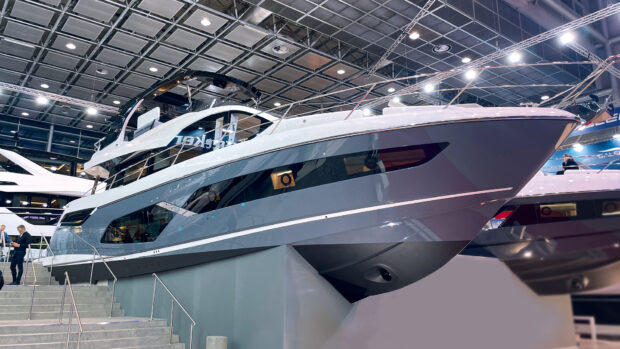I am a calm person with a restlesss mind. Living in the south-east of Sweden, close to the sea, boating has been a core part of my life for over 60 years. As well as having a shared interest in boating, my family also shares a workplace. We run a real estate firm in Karlskrona and named the business Utklippan after an island just outside Karlskrona archipelago.
My wife Eva and I started our boating life with a Flipper 620 when our youngest child, Andrea, was just five years old and our oldest, Martin, was ten. The Flipper gave us a lot of pleasure but as our children grew so did our need for space, so after five years we upgraded to an Aquador 26.
The Aquador lasted another seven seasons before we sold that and tried life without a boat for a while. We couldn’t remain boatless for long and soon bought another small craft, an open aluminium sportsboat called a Buster Magnum. We used it regularly all year round and my son Martin and I even competed in the Blue Ribbon gentleman’s race from Ystad to Haparanda, an 810-mile marathon across the Baltic Sea in less than 24 hours.
Now my restless mind has settled on a new goal, the Lofoten islands in the far north-west of Norway – some, 1,400nm away. Thankfully we now have a larger, more comfortable boat for tackling this challenge, a Grandezza 40 Fly named Deamare, which we took delivery of in 2017. Deamare alludes to the family and means “sea goddess” in Latin.

Heading down the Falsterbo Cana. Photo: Per Harrtoft
She has proved to be the ideal boat for us, both in terms of her layout and seaworthiness. The heavily glazed saloon keeps us wonderfully warm during the season but is filled with natural light and still allows us to admire the view out. A few steps down from the saloon are two good-sized cabins and a large galley open to the windscreen above, which means the chef never feels cut off from the action.
She came extremely well-equipped from the shipyard, including a pair of 370hp Volvo Penta D6 engines on sterndrives that deliver an impressive top speed of 37 knots and an efficient fast cruising speed of 31 knots, but I have installed a few more things like an electronic kill cord to suit my style of cruising. As I only have two months in which to complete this trip, I plan to cover big distances at speed when decent weather windows occur.
Karlskrona to Helsingor I spot the first of these coming at the end of May. The time has come to start my journey north and, having brimmed the tanks in anticipation, I slip the lines in Karlskrona for the first stretch to Gothenburg. The sun is shining, the sea is calm and the winds remain light as I power out through the familiar waters.
It is a long straight leg with just the lightest surface ripple, allowing the Grandezza’s smooth- running hull to lap up the miles with ease all the way across Hanö Bay, where I pass east of Bornholm.
After two hours, I change course at Sandhammaren lighthouse only to be greeted by a messy chop, forcing me to slow down to a much less economical 14 knots in order to make the 14.00 bridge opening in Falsterbo Canal. After the Falsterbo Canal, the fairway turns north towards the Öresund Bridge and the sea settles. I choose to go more westward, closer to the Danish side after the Öresund Bridge, and soon arrive in my first planned port of call, Helsingör, having covered 157 miles.

Per and wife, Eva. Photo: Per Harrtoft
So far so good, but it has not gone entirely smoothly; the ceiling in the forecabin has come loose in the rough sea and later that evening I discover that the toilet no longer flushes. Not ideal…
Helsingor to Långedrag
The next day I am met by big waves outside the harbor of Helsingör and I cross the traffic separation zones as quickly as possible at right angles.
The rough seas in Öresund soon calm down after rounding the Kullen peninsula and I am able to gradually accelerate up to my preferred cruising speed of 31 knots en route to Kattegat.
When I pass inside of Hallands Väderö and the sea is still smooth, I call my good friend Ingemar who lives in Halmstad to see if he’s up for joining me on my travels North. After getting over the initial shock of what I am up to and the all-important thumbs up from his wife, Ingemar agrees to join me so I make plans to pick him up in Halmstad.

In Falsterbo Canal, waiting for the road bridge to open. Photo: Per Harrtoft
Now with crew to keep me company, we press on north with a course west of the Onsala Peninsula. We stick to the fairways through Gothenburg’s southern archipelago, past Nidingen, Donsö and several other famous islands until we reach Långedrag harbour, south of Gothenburg.
Article continues below…
Here, having ticked off 124 nautical miles, we replenish our depleted fuel supplies and moor with the bow to the bridge in one of the free marked green berths. Långedrag is an active harbor with all the amenities we need to carry out running repairs so we decide to stay a few days and prepare the boat properly for the journey ahead.
Ingemar helps me reattach the loose ceiling lining, while Jörgen (an old friend of ours who lives in Gothenburg) sets to work replacing the water pump for the toilet. We also repair the sonar and install a battery charger for the genset, making the most of the pause in our schedule and enjoying the sense of satisfaction it gives.
After three days, my new crew arrives – my son Martin and his wife Ebba with their two young children, Frans and Hugo. I move my things to the forward cabin so the four of them can live in the master cabin for the ten-day trip to Bergen. Jörgen, meanwhile, will drive their motorhome to Bergen so they can swap places on arrival.

Preparing to pass under the 5-mile-long Oresund bridge linking Sweden to Denmark. Photo: Per Harrtoft
Långedrag to Gullholmen
After four days in port, it feels good to crank up the engines once again. The wind is blowing briskly from the west, so we decide to head north through the archipelago instead of directly west towards Kristiansand in Norway as planned.
The sea is quite rough as we tiptoe our way across the enormous exposed inlet of Gothenburg on our route north. Wherever possible we seek shelter from the waves in the lee of the islands, Martin and I taking turns at the helm to ease the stress of concentration as we pick our way through the worst of it. After passing the party island of Marstrand, we duck inside Tjörn to avoid the waves and keep the speed up.
The plan works and we enjoy a pleasant ride, making the most of the scenery and keeping the little sailors entertained. However, most of the time the motion of the boat and the drone of the engines works its magic, sending Hugo to sleep in seconds, with Frans following a few minutes later.

Two-year-old Frans lends his grandfather a hand with helming duties. Photo: Per Harrtoft
By late afternoon we have reached the island gem of Gullholmen, where thanks to our pre-season timing we are relieved to find there is plenty of space in the harbour. Once again though, the constant pace has taken its toll on Deamare, triggering an electrical failure which means we get no power from either the shore lead, the generator or the inverter.
That puts a stop to making any further progress today so we move to Ellös, 3 miles away on the mainland, where we can get quicker assistance from home. It turns out to be an electrical cable to one of the sockets in the master cabin, which has chafed against the diesel tank and shorted. Finding the cause and an equally quick resolution to it comes as a big relief, as it means we can crack on with our journey tomorrow.
Ellös to Risor, Norway
Today we are finally hoping to reach Norway but as soon as we leave the shelter of the archipelago and set course for Kristiansand across the Skagerrack sea we are met by heavy waves straight on the bow. In these conditions the best way to make comfortable progress is by maintaining a bow-up semi-displacement attitude of 12-14 knots but at this pace the fuel burn goes through the roof so we reduce speed to 8.5 knots to keep consumption under control.
After almost two hours of stomping through the waves, we change course and head due north instead towards Stavern. Now we can get up to planing speed and maintain a comfortable 24 knots. What had been a tedious slog now becomes an enjoyable passage and after a couple of hours skipping across open sea we moor in Stavern with another 77nm safely under our belts. The sun is shining once again and the holiday atmosphere of this bustling harbour gives off an almost Mediterranean vibe, even though we are now in Norway.

The boat suffered an electrical failure in Gullholmen. Photo: Per Harrtoft
We agree to press on from Stavern after a good lunch and a light nap has restored energy for young and old alike. It’s a lovely place but we have ended up quite a long way east of our intended destination and I am keen to get back on course. After filling up the tanks, we cruise west, initially over flat, open water, making good speed. As the sun dips lower in the sky, we end up back amongst the islands and the last stretch inside Big Vardöya to Risör looks particularly beautiful in the golden glow of the setting sun.
Before putting the boys to bed we run through the events of the day together, remembering the highs and lows of another long day on the water. I am lucky to have such a great crew. Despite the difficult start to the day, there have been happy faces all round with Frans leading the charge by giving a thumbs up at the start of every passage.
Risor to Korshamn
Today’s first destination is Kristiansand and we start well, staying inshore to make the most of the eerily calm waters. We maintain such a good pace that before long we arrive in Kristiansand with enough time in hand for the kids to take advantage of a nearby playground, followed by a relaxed lunch in the centre of town.

Gorgeous Gullholmen, with lots of free space and Deamare docked alongside. Photo: Per Harrtoft
By the time we leave Kristiansand the waves have built up a fair bit but as it’s a following sea we can still keep up a good pace, surfing from wave to wave in comfort. The journey is still inshore and we pass within a few hundred feet of the Michelin-starred restaurant called Under, where diners eat underwater at Spangereid. The building looks spectacular and we promise that next time we will make time to stop and eat there.
Our next landmark is the headland at Lindesnes, an exposed and infamous passage for which multiple warnings apply, especially in wind-against-tide situations. We leave the protection of the islands behind and head out to meet the sea.
The wave heights build rapidly to 2m but much to our relief they remain with us rather than against us, allowing us to maintain our current speed and heading without discomfort. This is our first big challenge and it feels good to overcome it and tuck back into the lee behind the headland, where safe conditions for the boat and the crew are all but guaranteed.
We enter a pretty little inlet lined with wooden houses and bridges leading to Korshamn where we dock at the visitors’ pier provided. It is a beautiful spot with a lively community huddled next to the water with a mountain rising steeply behind it. Martin and Frans set off on the usual hunt for a playground where they can kick a ball. I take the opportunity to Facetime Eva as today is our coral wedding anniversary.
Korshamn to Skudeneshavn
Before leaving Korshamn, we stop off at the fuel jetty. Diesel feels cheap here as we have to pay at least 6 SEK (45p) more per litre in Sweden but Norwegian boat owners are less happy, having had to swallow a 100% increase in the price of fuel since last summer.

Lindesnes lighthouse crowns this dramatic headland. Photo: Per Harrtoft
Once again we start the day sheltered by some smaller islands but we are soon out of the archipelago and in the Atlantic Ocean on a long and unprotected passage. Luckily, although the swell is sizeable, it is widely spaced and travelling in the same direction as us so we can cruise at 31 knots and enjoy the gentle roller coaster ride. The kids fall asleep quickly like the accustomed little sailors they are becoming.
The journey continues at good speed and we follow the coast until Egersund, where we pause for a much-needed rest and some lunch.
After Egersund we are met by a head sea as the wind direction has turned against us and we have to slow down. The next 20nm are uncomfortable and hard won before the sea subsides and we pick up shelter behind the islands of Tjör and Rott, south of Tananger. Everyone perks up, especially when we see porpoises jumping in our wake. High on endorphins from our dolphin encounter, we decide to celebrate with ice-cream all round.
The weather is now so good that we can drive at full speed in comfort, so instead of stopping at Stavanger, we put the throttles down and power on towards the little town of Skudeneshavn on the south side of Karmöy.
The entrance to Skudeneshavn is narrow and chocolate-box pretty, lined with a long row of large, white wooden houses with immaculate gardens rolling down to the water’s edge. This carries on all the way into the centre of town where multiple piers connect the sea to a maze of equally perfect narrow streets.

Moored alongside in the city centre of cosy Skudeneshavn. Photo: Per Harrtoft
It feels like we’ve entered a fairy tale landscape where everything has been designed around visiting boaters’ needs. We dock next to the service building and head straight off on a tour of discovery. After a quick shower in the free and perfectly clean facilities, we wander into town and enjoy a restorative lunch at a simple restaurant before examining the route and weather for tomorrow’s passage.
Skudeneshavn to Bekkjarvik
Our departure from Skudeneshavn is as memorable as our arrival, with bright sunshine and flat water illuminating the picture perfect scene. We even get to see porpoises again as we motor southeast towards Lysefjorden.
The views are stunning with mountains towering over the islands on the mainland. Before long we enter Lysefjord itself. The fjord is between half a mile and a mile wide and has very few mooring places available so we simply kill the engines and allow ourselves to drift in the deep, peaceful and still waters below Preikestolen.

The crew give a thumbs up in Bergen. Photo: Per Harrtoft
We take advantage of our surroundings to enjoy a brief but invigorating dip in the ice-cold water before warming up with a hearty lunch on board and heading back to Stavanger for a night in port.
Börevigå guest harbour is close to the centre of town and we are pleasantly surprised by the colourful, winding streets bristling with shops, restaurants and other distractions. Stavanger is actually a major hub for the offshore oil drilling industry (we passed one of the large oil rigs earlier in the day) but the town itself is surprisingly pretty.
After Stavanger, we continue over open water east of Karmöy then pass under the arched bridge leading to Haugesund. A large strait cuts through the city providing good protection from the sea, which makes it the ideal port for visiting commercial sea traffic.

Korshamn is home to a bustling community. Photo: Per Harrtoft
After a short stop in Haugesund, we head north towards Bekkjarvik. Everyone seems to own a boat here and we pass countless small craft helmed by people of all ages who seem to know these waters like the backs of their hands. We, conversely, have to keep a close eye on the charts as we carefully thread our way through the narrow channels separating the islands and skerries south of Bekkjarvik.
It’s a challenge we all enjoy, requiring lots of active steering from the helmsman and a careful look out from everyone aboard.
Bekkjarvik to Bergen
Our last leg with this crew is to Bergen and once again we are greeted the next morning by calm waters allowing us to hoover up the 29nm passage in short order.
We enter Bergen after little more than an hour at sea and meet Micke and Cina from our home marina on their stunning Grand Banks 48. They are also heading for Lofoten and have been ahead of us until now, feeding us handy tips about where to go and what to see.

Flat calm conditions en route to Lysefjorden. Photo: Per Harrtoft
Bergen is one of Europe’s rainiest cities with an average of 2,250mm of rainfall per year. Sure enough our walk through town is accompanied by pouring rain, forcing us to take cover in an ice-cream shop much to the children’s delight.
We continue round to the other side of the bay and find a great playground while the rain increases in strength. Tomorrrow we are due a crew change. After ten memorable days and 500nm of magical cruising, Martin and Ebba and their delightful children Hugo and Frans will head back to Sweden in their motorhome, while Jörgen will join us for the long journey north, where hopefully more adventures await.
Next month Per and Jörgen push on north through steep seas and mirror-calm fjords to Malöy and Ålesund, before making the final crossing to the remote islands of Lofoten.
 If you enjoyed this….
If you enjoyed this….
Motor Boat & Yachting is the world’s leading magazine for Motoryacht enthusiasts. Every month we have inspirational adventures and practical features to help you realise your sailing dreams, as well as tests and news of all the latest motorboats.
Plus you’ll get our quarterly Custom Yachting supplement where we share the last on offer in the superyacht world and at the luxury end of the market.
Build your knowledge with a subscription delivered to your door. See our latest offers and save at least 30% off the cover price.



 If you enjoyed this….
If you enjoyed this….





